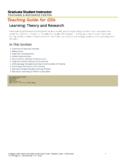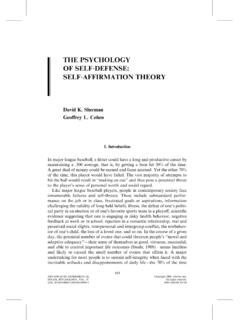Transcription of Critical Race Theory and Education History, Theory, and …
1 Critical Race Theory and Education : History, Theory , and Implications Author(s): William F. Tate IV. Source: Review of Research in Education , Vol. 22 (1997), pp. 195-247. Published by: American Educational Research Association Stable URL: Accessed: 22-10-2018 15:43 UTC. JSTOR is a not-for-profit service that helps scholars, researchers, and students discover, use, and build upon a wide range of content in a trusted digital archive. We use information technology and tools to increase productivity and facilitate new forms of scholarship.
2 For more information about JSTOR, please contact Your use of the JSTOR archive indicates your acceptance of the Terms & Conditions of Use, available at American Educational Research Association is collaborating with JSTOR to digitize, preserve and extend access to Review of Research in Education This content downloaded from on Mon, 22 Oct 2018 15:43:01 UTC. All use subject to Chapter 4. Critical Race Theory and Education : History, Theory , and Implications WILLIAM F. TATE IV. University of Wisconsin-Madison In 1993 President Clinton nominated Professor Lani Guinier of the University of Pennsylvania Law School to be assistant attorney general in charge of the Civ Rights Division.
3 Her nomination for this government post resulted in a large con troversy centering on her scholarship (Guinier, 1991a, 1991b). Guinier's research which examined voting systems, asked the following question: Are there factors th guarantee winners and losers? She contended that such factors do exist and that rac is too often an important factor in the construction of voting districts, the outcome of elections, and ultimately political influence, including the control of educationa systems. Guinier (1989) argued that the political system must be rejuvenated to b more inclusive.
4 Specifically, she called for the creation of electoral schemes tha would allow Blacks to elect candidates representing their interests. These schemes-proportional voting, in particular-were already a reality in many south ern localities and had received endorsement from the Reagan-Bush Justic Department and the Supreme Court. Professor Guinier also was Critical of politic bargaining between leading civil rights groups, African American politicians, an Republicans that resulted in the construction of guaranteed African American leg islative districts and conservative White districts in adjacent jurisdictions.
5 Guinier's position sparked great controversy among both liberals and conservatives. In the epilogue of Racial Formation in the United States, Omi and Winant (1994. posited that this controversy had little to do with Guinier's position on the issue of voting districts; rather, her "sin" was her eagerness to discuss the changing dimen- sions of race in contemporary politics. Omi and Winant (1994) remarked: Guinier's recognition that, in the post-civil rights era as previously, racial injustice still operates, th it has taken on new forms, and that it needs to be opposed if democracy is to advance, in our view located her in a far more realistic position.)
6 Guinier understood the flexibility of racial identities an I would like to thank Michael Apple (editor) and Gloria Ladson-Billings (editorial consultant) fo their feedback on this chapter. Also, a special thanks to Carl Grant, Ron Jetty, Kimberly Tate, an Jessica Trubek for their valuable assistance with this project. 195. This content downloaded from on Mon, 22 Oct 2018 15:43:01 UTC. All use subject to 196 Review of Research in Education , 22. politics [italics added], but also affirmed that racism still shapes the social structure in a wide- spread fashion.
7 She resisted the idea of closing Pandora's box; in fact she denied the possibility of closing it, arguing the racial dimensions of politics are too complex, too basic, and too subtle to be downplayed for long. (p. 156). Ladson-Billings and Tate (1995) asserted that, despite the salience of race in society, it remains untheorized as a topic of scholarly inquiry in Education .' Over the past three decades, theoretical and philosophical considerations of gender have been delineated and debated (Chodorow, 1978; Damarin, 1995; DeBouvoir, 1961; Harding, 1986; Hartsock, 1979).
8 Similarly, Marxist and neo-Marxist analy- ses of class continue to frame many explanations of social inequality (Apple, 1992; Bowles & Gintis, 1976; Carnoy, 1974; Frankenstein, 1987).2 Although gender-and class-based analyses continue to struggle for legitimacy in academe, educational studies conceptualized on these theoretical precepts abound (see reviews by Ewert, 1991; B. M. Gordon, 1995; Noddings, 1990; Schmitz, Butler, Rosenfelt, & Guy-Sheftall, 1995). Ladson-Billings and Tate (1995) recognized the importance of gender-and class- based analyses; however, they asserted that the significance of race in the United States, and more specifically "raced" Education , could not be explained with theo- ries of gender or Similarly, McCarthy and Crichlow (1993) argued that the subject of racial domination has, to say the least, been treated problematically in modem educa- tional and social theories.
9 Racial logics and mechanisms have been difficult to specify, their persis- tence difficult to explain, and their dynamics and trajectories difficult to predict. Indeed, the very slippery nature of what has come to be known in the educational literature as the "race question" chal- lenges in fundamental ways the entire tapestry of curriculum and educational thought, particularly with respect to nonclass social antagonisms and domination relations in general. That is to say, the race question brings into the foreground omissions and blind spots.
10 (p. xvii)4. These omissions and blind spots suggest the need for theoretical perspectives that move beyond the traditional paradigmatic boundaries of educational research to provide a more cogent analysis of "raced" people and move discussions of race and racism from the margins of scholarly activity to the fore of educational dis- course. King (1995) stated: Conceptual intervention in the educational research literature is needed to facilitate a systemic exam- ination of scholarship that addresses ideological influence on knowledge in curriculum and Education practice, particularly with regard to the Education of Black people.





